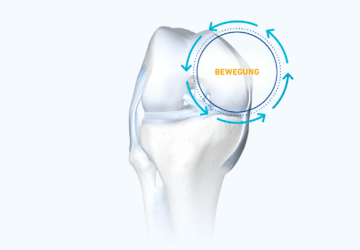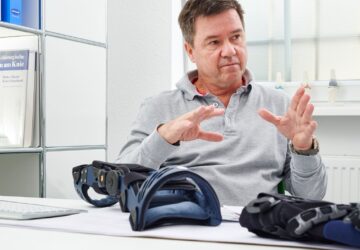In short Why orthopedic foot orthoses can do more for the treatment of mild to moderate osteoarthritis of the knee than many people think – and how they can provide noticeable relief – is explained by Dr. Andreas Metzger. The key to achieving the desired effect lies in the right fit, a suitable shoe, and the interaction of the foot orthoses with other treatment components.
Foot orthoses·Foot problems·Gonarthrosis
A key element of treatment
Orthopedic foot orthoses in cases of osteoarthritis of the knee
From Bauerfeind Life on 29.10.2025
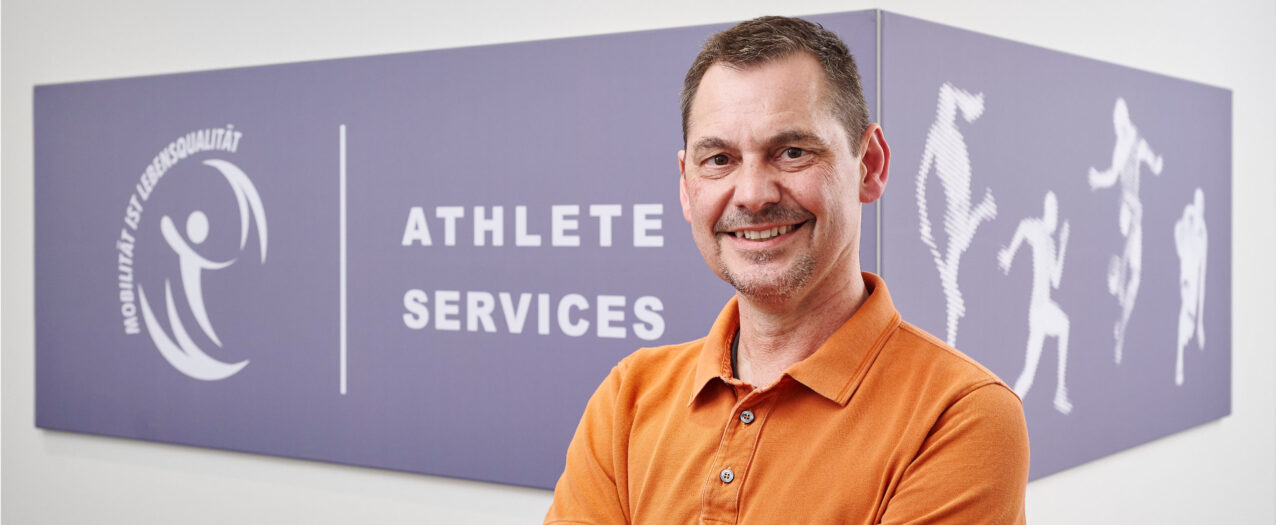
According to the German guidelines,[1] foot orthoses “can be considered” during early treatment of osteoarthritis of the knee. “You have to interpret this open recommendation correctly,” insists Dr. Andreas Metzger, Specialist in Orthopedics and Sports Medicine with his own practice in Nuremberg. He sees foot orthoses as an important addition to his multi-modal treatment regime.
“For the non-surgical treatment of mild to moderate osteoarthritis of the knee, orthopedic foot orthoses, in addition to injection therapy using hyaluronic acid or the patient’s own plasma, muscle-building physiotherapy, and knee braces in cases of instability, are among my top 5 treatment elements,” says Dr. Andreas Metzger and refers to the causes that exacerbate osteoarthritis of the knee. Leg axis misalignments, for example, can be pivotal for excessive strain in the knee joint. “A typical example would be a man with bandy legs where you would much more often see increased wear on the inside of the medial compartment caused by the varus leg axis. Or a woman who is prone to a valgus axis in the knee and will therefore more likely suffer from osteoarthritis in the lateral area,” Dr. Metzger explains. Another factor is when knee joints are no longer as stable as before, perhaps caused by a tear of the anterior cruciate ligament. If this remains undetected or untreated for an extended period, these people will risk faster wear of the cartilage owing to the translation movements that occur. Or put in a biomechanical way: apart from the pure vector of force that runs from the bottom to the top in an ascending chain, it is about which movements are generated in the knee by these forces. It is not just the axis alignment of the thigh and lower leg that makes a difference here. The posture of the foot also plays an important role. “If a foot is very flexible in its longitudinal arch, i.e. with a pronounced pronation movement from the landing to the standing phase, then the leg axis will not just tend toward a bandy leg shape but the lower leg will also twist. This tibial internal rotation and the more pronounced valgus seems to exacerbate wear.” Other factors can also have an impact, such as the shape of the articular surface or of the kneecap.

Controlling strain, preventing pain
“Treating osteoarthritis always aims at preventing pain. This is a result from inflammatory activation in the joint. Strain should therefore be kept below a certain limit – according to the motto: a lot of activity with little strain,” Dr. Metzger explains. Foot orthoses come into action at the bottom end of the locomotor system and can noticeably influence posture, in particular the leg axes. Raising an arch-decreased or flat foot using an arch-supporting foot orthosis, for example, can increase knee stability and reduce internal rotation. “The effect will be all the greater, the more unstable the knee joint is – in my opinion, a parameter that is also not considered enough in many studies, just like the design of the foot orthosis used,” says the experienced orthopedist and recommends having a look at the underlying studies when interpreting guidelines.
“We see the positive effects of foot orthoses in particular with patients suffering from mild to moderate osteoarthritis of the knee in the medial compartment with an unstable knee and foot arches.”
Dr. Andreas Metzger
Focus on supporting the longitudinal arch
According to Dr. Metzger, the supporting effect of foot orthoses has an impact in particular on patients suffering from mild to moderate osteoarthritis of the knee in the medial compartment with an unstable knee and foot arches. “Supporting the longitudinal arch is the most important thing for stabilization. This support must be tailored to the specific patient’s foot. If we also want to influence the axis alignment, in cases of varus knee, for example, we can easily achieve this by raising the outer edge of the foot orthosis.” He recommends starting moderately. Three or five millimeters. Too much can change the biomechanical sequences such that, yes, the intra-articular space will open up, but the pes anserinus, the tendon conglomerate on the medial side of the knee, will be subjected to excessive strain and start to hurt.
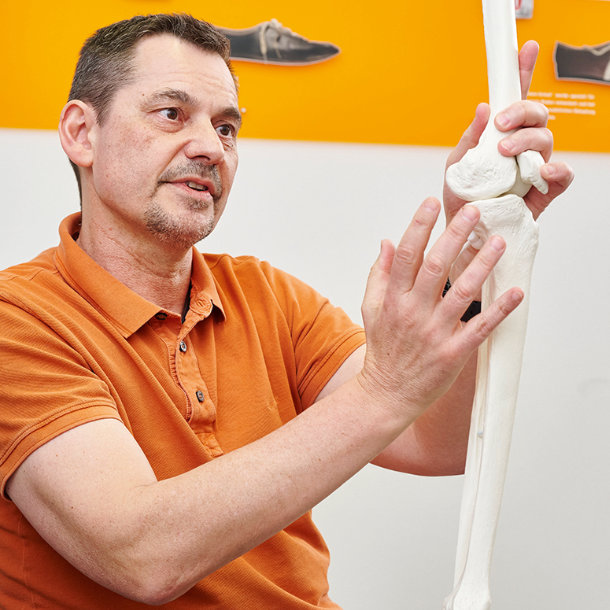
In addition to pronounced support of the longitudinal arch and raising the edge the perfect amount, the appropriate heel grip will also stabilize the foot. For this, the selection of footwear in which the product will be worn is also a factor alongside the design of the foot orthosis. “The best outer edge increase will have no effect if the intermediate sole of the shoe is too soft. You may feel like you’re walking on clouds but there’s not enough resistance where the edge has been raised to generate an effect,” Dr. Metzger notes. During everyday wearing, he has noticed that lightweight hiking shoes or footwear for Nordic Walking provide a varus knee in particular with a certain basic stability without impairing the heel-to-toe movement of the foot. Those suffering from valgus knee should look for running shoes instead.
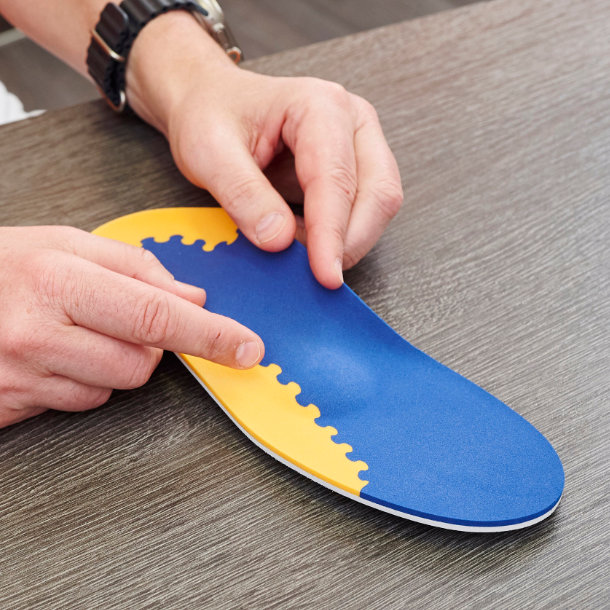
In general, when prescribing foot orthoses for osteoarthritis of the knee, Dr. Metzger makes sure he only ever prescribes long-sole models that also feature appropriate stabilizing elements, such as longitudinal arch support, a raised edge, and heel grip, in addition to certain soft cushioning to reduce impact. Based on his experience, Dr. Metzger specifies the height of the pronation wedge. “I’ll leave the rest to the expertise and treatment freedom of the experienced orthotist. This person will create the foot orthoses that fit the relevant footwear and adapt them during fitting. After about two weeks of using the product, I’ll always check the fit.”

Combining measures is successful
“There are studies which substantiate that even foot orthoses by themselves can have a positive effect,” says Dr. Metzer, but adds: “Other studies show, however, that pain reduction and functionality can be significantly improved again when using foot orthoses in combination with other treatment elements, such as physiotherapy or a knee brace.” The physician therefore regards foot orthoses as a key addition to other measures, and elaborates: “If you look at injection therapy using hyaluronic acid or the patient’s own plasma, studies attribute these a higher proven level of effectiveness compared with foot orthoses. But that doesn’t mean only one option should be used. As is often the case, the following applies to non-surgical orthopedics, too: one plus one is sometimes more than two.”
“Studies show that pain reduction and functionality can be significantly improved again when using foot orthoses in combination with other treatment elements, such as physiotherapy or a knee brace.”
Dr. Andreas Metzger
The results speak for themselves. A treatment combination adapted to the individual patient will have the best outcome. And using foot orthoses as part of his top 5 treatment measures can make a contribution to this, according to Dr. Metzger. Problems with compliance are rare. Only if the patient also suffers from other foot deformities, such as hallux valgus or hallux valgus et rigidus, it may happen that the foot orthosis module used disagrees with other indications. “You’ll then have to weigh up and adjust,” the physician explains. “Otherwise, foot orthoses are one of the best accepted aids. Even if they sometimes feel a little obstructive in the beginning, most patients get used to them very quickly and notice their positive effect.”
Orthotic blank in cases of osteoarthritis of the knee: TRIactive Select OA
The TRIactive Select OA orthotic blank has been designed for the conservative treatment of patients with medial or lateral osteoarthritis of the knee (varus or valgus osteoarthritis of the knee). It can help alleviate symptoms as well as reduce pain. After a medical retailer has adjusted the product to the individual patient, the finished foot orthosis will correct the muscular ligament structures and axis misalignments, stabilizing the muscles and ligaments from the feet up. This improves overall posture, positively influences gait, and minimizes one-sided wear in the intra-articular space.
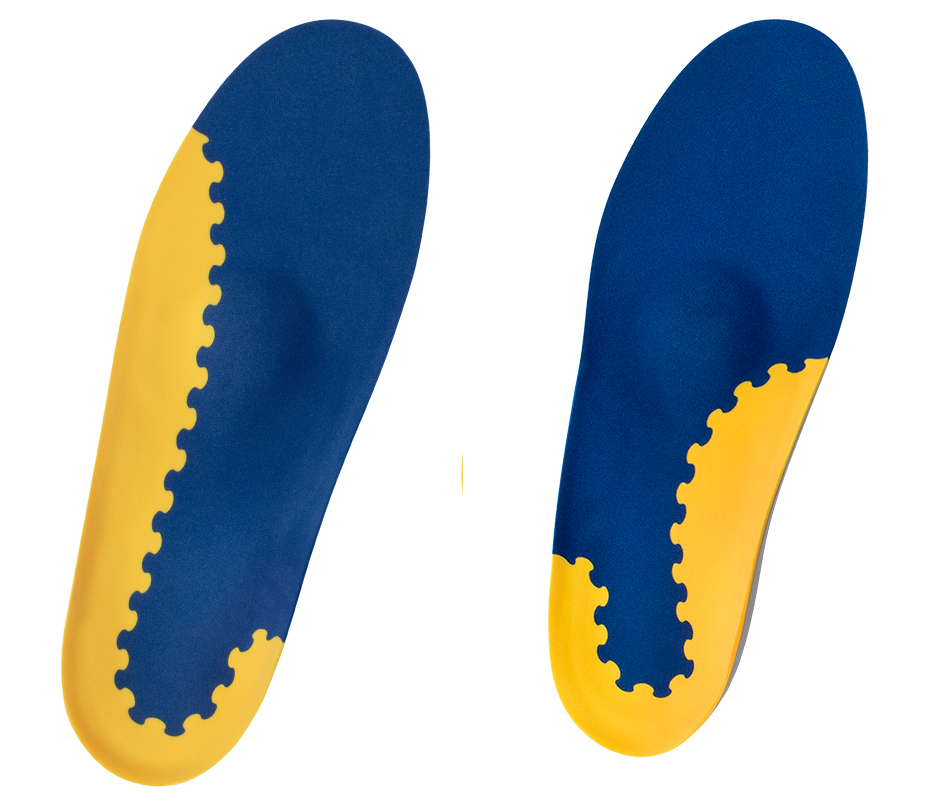
[1] https://register.awmf.org/de/leitlinien/detail/187-050
Pictures: Udo Schönewald, Bauerfeind AG
Related topics
Product-Finder App

This app greatly simplifies the selection of suitable medical aids for doctors and specialist dealers. With its intuitive usability, information on Bauerfeind products is available everywhere – quickly and easily
